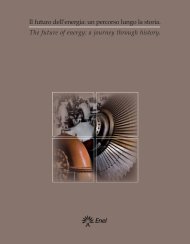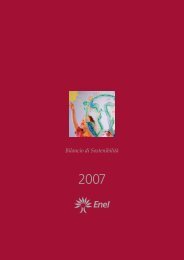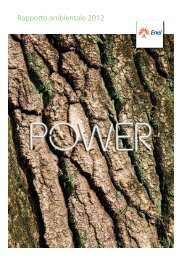Annual Report 2010 - Enel.com
Annual Report 2010 - Enel.com
Annual Report 2010 - Enel.com
You also want an ePaper? Increase the reach of your titles
YUMPU automatically turns print PDFs into web optimized ePapers that Google loves.
The recoverability of deferred tax assets is reviewed at<br />
each period-end. Taxes in respect of <strong>com</strong>ponents recognized<br />
directly in equity are also taken directly to equity.<br />
Dividends<br />
Dividends from equity investments are recognized when<br />
the shareholder’s right to receive them is established.<br />
Dividends and interim dividends payable to third parties<br />
are recognized as changes in equity at the date they are<br />
approved by the Shareholders’ Meeting and the Board of<br />
Directors, respectively.<br />
Discontinued operations and non-current<br />
assets held for sale<br />
Non-current assets (or disposal groups) whose carrying<br />
amount will mainly be recovered through sale, rather than<br />
through ongoing use, are classified as held for sale and<br />
shown separately from the other balance sheet assets and<br />
liabilities. Non-current assets (or disposal groups) classified<br />
as held for sale are first recognized in <strong>com</strong>pliance with<br />
the appropriate IFRS/IAS applicable to the specific assets<br />
and liabilities and subsequently measured at the lower<br />
of the carrying amount and the fair value, net of costs to<br />
sell. Any subsequent impairment losses are recognized as<br />
a direct adjustment to the non-current assets (or disposal<br />
groups) classified as held for sale and expensed in the in<strong>com</strong>e<br />
statement. The corresponding values for the previous<br />
period are not reclassified.<br />
A discontinued operation is a <strong>com</strong>ponent of an entity that<br />
has been divested or classified as held for sale and:<br />
> represents a major line of business or geographical<br />
area of operations;<br />
> is part of a single coordinated plan to dispose of a<br />
separate major line of business or geographical area<br />
of operations; or<br />
> is a subsidiary acquired exclusively with a view to resale.<br />
Gains or losses on operating assets sold – whether disposed<br />
of or classified as held for sale – are shown separately in the<br />
in<strong>com</strong>e statement, net of the tax effects. The corresponding<br />
values for the previous period, where present, are reclassified<br />
and reported separately in the in<strong>com</strong>e statement,<br />
net of tax effects, for <strong>com</strong>parative purposes.<br />
3<br />
Recently issued accounting<br />
standards<br />
First-time adoption and applicable<br />
standards<br />
The Group has adopted the following international accounting<br />
standards and interpretations taking effect as<br />
from January 1, <strong>2010</strong>:<br />
> “Amendments to IAS 27 - Consolidated and separate financial<br />
statements”. The new version of the standard<br />
establishes that disposals of equity interests in a subsidiary<br />
that do not result in a loss of control shall be<br />
recognized in equity in the consolidated financial statements.<br />
Similar treatment is required in the consolidated<br />
financial statements in the event of the acquisition of an<br />
additional stake in an existing subsidiary. Where a controlling<br />
interest is divested, any residual interest must<br />
be re-measured to fair value on that date, recognizing<br />
the effects through profit or loss. The application of the<br />
standard led to the recognition in equity of the gain (net<br />
of taxes and transaction costs) on the disposal of 30.83%<br />
of <strong>Enel</strong> Green Power in the amount of €796 million.<br />
> “Amendments to IAS 39 - Financial instruments: recognition<br />
and measurement: eligible hedged items”. With this<br />
amendment to the current IAS 39 standard, the IASB has<br />
clarified the conditions under which certain financial/<br />
non-financial instruments may be designated as hedged<br />
items. The amendment specifies that an entity may also<br />
choose to hedge only one kind of change in the cash<br />
flow or in the fair value of the hedged item (i.e. that the<br />
price of a hedged <strong>com</strong>modity increases beyond a specified<br />
price), which would constitute a one-sided risk. The<br />
IASB also specifies that a purchased option designated<br />
as a hedge in a one-sided risk hedge relationship is perfectly<br />
effective only if the hedged risk refers exclusively<br />
to changes in the intrinsic value of the hedging instrument,<br />
not to changes in its time value as well.<br />
The retrospective application of the standard did not<br />
have an impact in the period under review.<br />
> “Amendments to IFRS 2 - Share-based payment”. The<br />
amendments seek to:<br />
- clarify the scope of application of the standard,<br />
165









